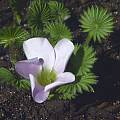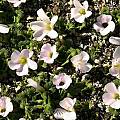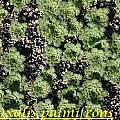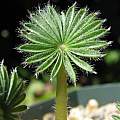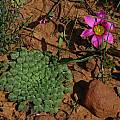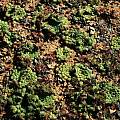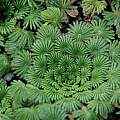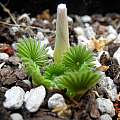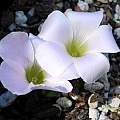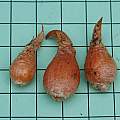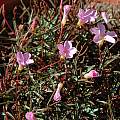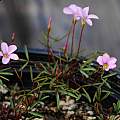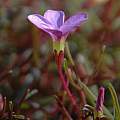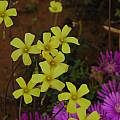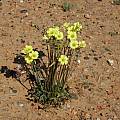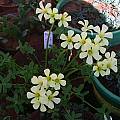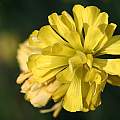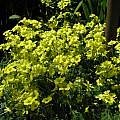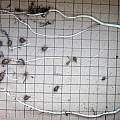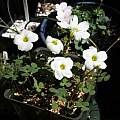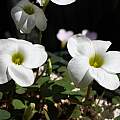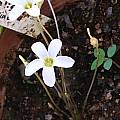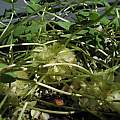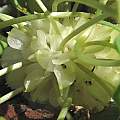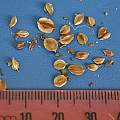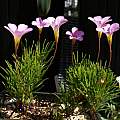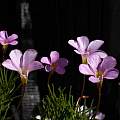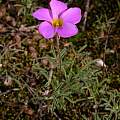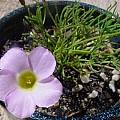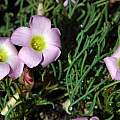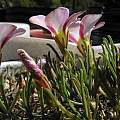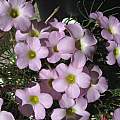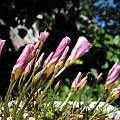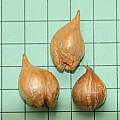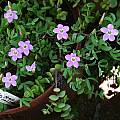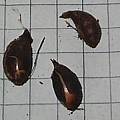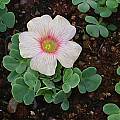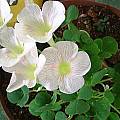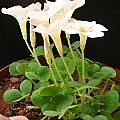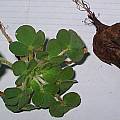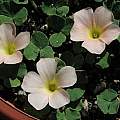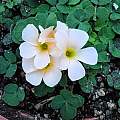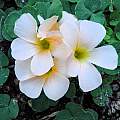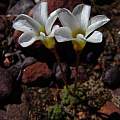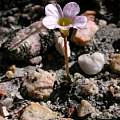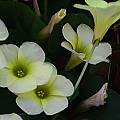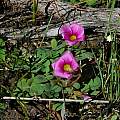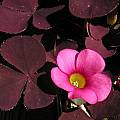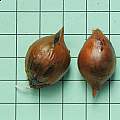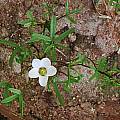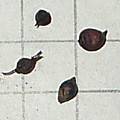There are more than 200 species of Oxalis in South Africa and 270 varieties and probably many new species as well. The only handbook on the Southern African species, by Salter, is almost sixty years old and out of print so there are many challenges in identifying them. Cape Plants, a conspectus of the Cape flora of South Africa by Peter Goldblatt and John Manning lists 118 in the Cape Floral Kingdom but there is only a brief botanical description, location sometimes with habitat information, and time of bloom in this book. South African species P are found on this wiki page.
Oxalis index - Miscellaneous Oxalis - Oxalis flava - Oxalis hirta - Oxalis obtusa - Oxalis pes-caprae - Oxalis purpurea - South African oxalis A-B - South African oxalis C -South African oxalis D-E - South African oxalis F-G - South African oxalis H-K - South African oxalis L-M - South African oxalis N-O - South African oxalis R-S - South African oxalis T-Z - South American oxalis
Oxalis palmifrons Salter is a winter growing species from the Western Karoo of South Africa with interesting leaves, growing about 8 cm high. Width can slowly extend to 40-60 cm, in very mature plants. This one is difficult to get to bloom in cultivation. It may need a deep pot. Photo 1 was taken by Sheila Burrow and photos 2-3 by Bill Dijk, including one with a good display of flowers. Photo 4 taken by Nhu Nguyen shows a closeup of the leaf.
Photos below were taken by Mary Sue Ittner. The first two photos were taken September 2006 in the Roggeveld of the leaves. The flower in the first photo is Romulea subfistulosa. The other photos are of plants in cultivation showing leaves, bud, flowers and the bulbs on a 1 cm grid. After years without seeing flowers now with larger bulbs in deep pots plants are flowering regularly.
Oxalis pardalis Sond. is found in the winter rainfall areas, usually in heavier soils, and has trifoliolate leaves and flowers in many different colors. Height: to 30 cm. It blooms in the fall. Photo by Bill Dijk.
Oxalis pardalis MV7632 is a fall to early winter blooming species with thin, thread-like bronzy foliage on a bushy plant. It is topped by a long period of medium pink flowers. Although it was received without a species name, it has been identified by Dr. Leanne Dreyer, who was rather certain it was a part of the Oxalis pardalis group. Text from Ron Vanderhoff, photos from Mary Sue Ittner including a photo of the bulbs on a 1 cm grid.
Oxalis pes-caprae L. - see the Oxalis pes-caprae page.
Representative photos of this species. Photo 1 by Mary Sue Ittner, photo 2 by Bob Rutemoeller, photo 3 by Christiaan van Schalkwyk, photo 4 by Pieter van der Walt, photo 5 by Nhu Nguyen, and photo 6 by M. Gastil-Buhl.
Oxalis pocockiae L. Bolus is similar in appearance to O. depressa, but can be distinguished by looking at the bulbs; those of O. pocockiae have four longitudinal wings. It also produces numerous aerial bulbils, and often the flowers appear before the leaves. It is found over large parts of the Karoo, and therefore many different forms can be expected. Flowers have a wonderful scent similar to coconut. Photos 1-2 were taken by Nhu Nguyen. Photos 3-4 by Christiaan van Schalkwyk show the white form which is found east of Fraserburg, and the pink form is from Carnarvon.
Photos 1-2 by Nhu Nguyen show aerial bulbils which are produced copiously by each bulb. Photo 3 from Kiyel Boland also shows the bulbils which could easily be confused with seed.
Oxalis polyphylla Jacq. is a winter-growing species usually found on flats, light or heavy soils in the southern Cape (Malmesbury to Port Elizabeth). Growing to 20 cm with a bulb that is often gummy, it has rose, lilac or white flowers with a yellow tube and often darker margins, linear leaflets folded lengthwise and flowers March to June. The first two photos below were taken by Nhu Nguyen of plants from Telos Rare Bulbs. The last photo from the CD of the book Plants of the Klein Karoo courtesy of Jan and Anne Lise Schutte-Vlok.
Oxalis polyphylla var. heptaphylla is a winter growing, fall blooming South African species. Photo 1 was taken by Lyn Edwards. Photos 2-3 from Mary Sue Ittner and Bob Rutemoeller are offsets from plants originally collected by Michael Vassar as MV6396 at Vanrhynsdorp, Northern Cape, South Africa. It was described as: succulent thread-like leaves with up to 8 leaflets to a stem; corms often gummy; large satiny-lavender flowers. Photos 4-5 from Nhu Nguyen of the same clone, show a nice mass blooming in pot and the back of the petals when closed. The last photo shown from Mary Sue Ittner is of the bulbs on a 1 cm grid.
Oxalis primuloides R. Knuth, or so I think! A small species (3-6 cm) from the Karoo. It has fairly thick bulbs with relation to its length, with brown papery tunics (Shown here on a 1 cm square grid). Photos by Christiaan van Schalkwyk.
Oxalis pulchella Jacq. is a polymorphous group of plants, ranging from glabrous to pilose/hirsute. SANBI lists four possible varieties: var. glauca, var. leucotricha, var. pulchella, var. tomentosa and Cape Plants describes it as found on sandy lower slopes and flats at 250 to 450 m from southern Namibia to Swellendam (southwestern Cape). It blooms from May to June. Flower colours include white, pale yellow, yellow, salmon-rose and rose. The first form is from Koingnaas in Southern Namaqualand, and is totally glabrous. The second form pictured below is from west of Steinkopf, Namaqualand, with very large flowers. The last photo show the bulb structure, the plant slightly villose, from ENE of Kamieskroon. Photos by Christiaan van Schalkwyk.
Oxalis pulchella var. tomentosa Sond. is a variety with low, pubescent, mat forming foliage and large very pale salmon colored flowers. Photos from Mary Sue Ittner who obtained it from the Pacific Bulb Society BX in 2009. It did not bloom until the fall of 2013 (October-November). She started it into growth late summer this year and like many other fall blooming species she grows it may benefit from early watering before it starts to rain in California so it will have been in growth long enough at the time it normally would bloom and before the temperatures get colder.
Oxalis punctata Thunb. is a widespread species that occurs from the Cape Peninsula to the Eastern Cape. Growing up to 8 cm, it has a small sharply angled and pitted bulb, leaves with 3 round to heart shaped somewhat succulent leaflets and one lilac pink or white with a yellow center flower per stalk. Plants flower in autumn and winter (April to June). Photos from the book Plants of the Klein Karoo courtesy of Jan and Anne Lise Schutte-Vlok.
Oxalis purpurea L. is a long blooming winter growing oxalis that is widespread on flats and slopes from Namaqualand to Caledon in the Overberg. For more information and photos see the Oxalis purpurea page.
Representative photos of this species taken by Christiaan van Schalkwyk, Mary Sue Ittner, Bob Rutemoeller, and Ron Vanderhoff are pictured below.
Oxalis pusilla Jacq. was once regarded as a variety of Oxalis glabra, but differs in root and bulb structure from that species. It is a small plant, and does not seem to multiply quickly (at least for me). The reddish-purple eye in the throat of the flowers is apparently rare. The bulbs are very small and round, with a pointed apex. The tunics are smooth and dark brown. The grid is 1 cm. Photos by Christiaan van Schalkwyk.
Oxalis index - Miscellaneous Oxalis - Oxalis flava - Oxalis hirta - Oxalis obtusa - Oxalis pes-caprae - Oxalis purpurea - South African oxalis A-B - South African oxalis C -South African oxalis D-E - South African oxalis F-G - South African oxalis H-K - South African oxalis L-M - South African oxalis N-O - South African oxalis R-S - South African oxalis T-Z - South American oxalis
